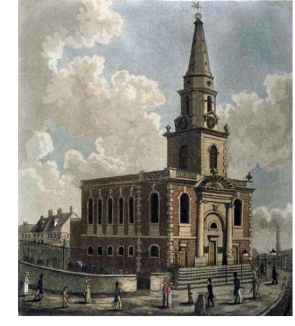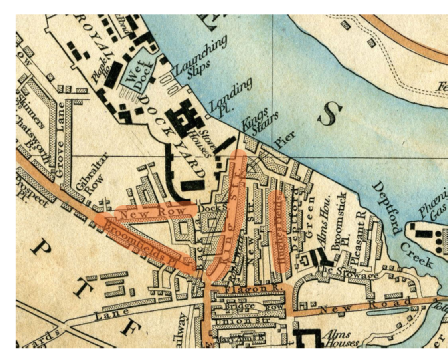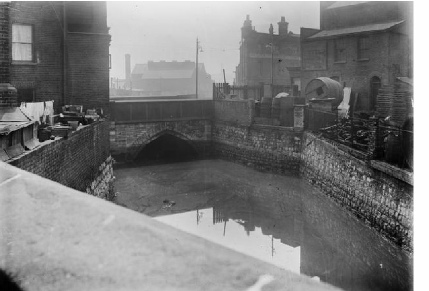 Early years
Early years
Eleanor was born on 21 June 1802, the eldest child of William and Eleanor Evans,
and was baptised a few weeks later at the Church of St George the Martyr. The Church
(shown in the illustration on the right and marked on the map of 1804) stands at
the intersection of Borough High Street and Great Dover Street in Southwark in south
London. In the three centuries before Eleanor’s birth, the area was notable for two
things: prisons and taverns.  Five of London’s eighteen prisons were located in Southwark,
including the famous Marshalsea and Clink prisons, which were only a few streets
from the Church. As famous as its prisons was its inns. Borough High Street was the
main thoroughfare to London Bridges and, as such, was an entry point to London from
Portsmouth in the south and Dover in the southeast. The High Street was characterised
by its many coaching inns and taverns, many of which were ancient establishments
such as The Tabard Inn (the meeting place of the pilgrims in Chaucer’s Canterbury
Tales) and the George and Dragon which was frequented by William Shakespeare and
referred to in Dickens’ novel, Little Dorritt.
Five of London’s eighteen prisons were located in Southwark,
including the famous Marshalsea and Clink prisons, which were only a few streets
from the Church. As famous as its prisons was its inns. Borough High Street was the
main thoroughfare to London Bridges and, as such, was an entry point to London from
Portsmouth in the south and Dover in the southeast. The High Street was characterised
by its many coaching inns and taverns, many of which were ancient establishments
such as The Tabard Inn (the meeting place of the pilgrims in Chaucer’s Canterbury
Tales) and the George and Dragon which was frequented by William Shakespeare and
referred to in Dickens’ novel, Little Dorritt.
At the time of Eleanor’s birth, her father was described using the somewhat vague
term of ‘labourer’, an occupation which encompassed a variety of jobs. In about 1803,
her parents moved from Borough, a few miles east to Deptford. It was here that Eleanor
and her five siblings grew up. In 1803, when the infant Eleanor and her family arrived
in Deptford, it was a thriving area of trade and industry and, until she was in her
early teens at least, Eleanor grew up amidst the bustle of the docks with the smell
of fresh sawn timber and tar in the air. The map below shows four of the streets
where Eleanor lived between 1804 and 1813.
T he next chapter
he next chapter
Little is know about Eleanor until the 1830s; in 1851, she described herself as a
tailoress, but there is no evidence to suggest she followed this occupation earlier
in life. By 1836, she had met a tailor called George Moss. Their son was born on
30 June 1837 whilst George and Eleanor were living above one of the shops that lined
the Broadway, the bustling thoroughfare a little further south of river. However,
the 1841 census (taken on 6 June) records two other children in the household: Eleanor
Moss born in about 1831 and Emma Moss born around 1833. No baptism records have been
found for Eleanor and Emma (under either the surname Moss or Evans). George may have
been their father, but there is nothing to prove or disprove it.
Only a few months after his birth, in the Winter of 1837, the infant George died.
Not long after his death, two events occurred: Eleanor discovered that she was pregnant,
and George and Eleanor moved from Deptford to Stratford in Essex. Historical evidence
doesn’t show which event came first: perhaps the death of their son, George, was
the impetus they had needed to move, or perhaps the discovery that she was pregnant
prompted George and Eleanor to find a better place to raise their children. Whatever
the order of events, Eleanor was living at New Street in Stratford when she gave
birth to a second son on 23 November 1838. It took until 1868 for his name to be
entered into the baptism register ‘by sworn affidavit’ of the Church of All Saints
in West Ham.
It appears that George and Eleanor were rather lax with church formalities. It was
not until 13 October 1839 that Eleanor and William finally decided to wed. Having
waited so long, they made sure it was a family affair, returning to Deptford and
the Church of St Paul to be married. Eleanor was thirty seven and had borne four
children, but the marriage entry in the parish register (shown below) gives no clue
as to why she and George had waited so long.

Hard Times
After their marriage, Eleanor and her family returned to Stratford, where Eleanor
gave birth to at least three more children: Rosetta (May 1841), William (1843) and
Eliza (1845). If the family had moved to Stratford in search of work and a better
life, they were disappointed. The middle years of the nineteenth century were difficult
ones for many trades and wages declined in real terms. In 1851, Eleanor described
her occupation as a tailoress, indicating that she had taken up her needled to assist
her husband to make ends meet.
The death of Eleanor’s husband, G eorge, sometime between 1851 and 1861, and the loss
of his income, left Eleanor, and her children who still remained at home (William
and Eliza), in financial difficulty, but the family managed to make ends meet. However,
by 1865, all of Eleanor’s children had left home and families of their own to support.
Eleanor moved to 75 Chapel Street (highlighted in yellow on the map on the right)
where she rented a room from a blacksmith and his family.
eorge, sometime between 1851 and 1861, and the loss
of his income, left Eleanor, and her children who still remained at home (William
and Eliza), in financial difficulty, but the family managed to make ends meet. However,
by 1865, all of Eleanor’s children had left home and families of their own to support.
Eleanor moved to 75 Chapel Street (highlighted in yellow on the map on the right)
where she rented a room from a blacksmith and his family.
By the 1870s she found it increasingly difficult to earn her living with her needle:
not only was her hand less steady and her eyesight less sharp, the widespread introduction
of the mechanised sewing machine had reduced the demand for needlewomen. As her circumstances
reduced, so did her living conditions. Her next move was only a step away from destitution
and the workhouse. Wood’s Yard (circled in red) was one of a number of courts and
alleys leading off of the High Street. Its ten hovels had been built in the early
nineteenth century and probably consisted of a brick basement with one or two weather-boarded
living rooms above; along with Dean’s Court and Channelsea Court, it was one of the
slums singled out for reprobation in a report of 1855 which looked at public health
and sanitation in West Ham. Of neighbouring Channelsea Court, the report noted:
“The inhabitants have no water except from the filthy river. Little back yards with
stinking privies. Cholera was very bad here. There is a drain running from the Forest-gate
district past the Stratford station of the Eastern Counties Railway. At that point
it is on the company’s land and partly covered. The open area is very bad … it takes
privy drainage and empties itself into the Channelsea river at a point above where
the inhabitants of the Rabbit-hutch row, and the Channelsea-court dip for their water”.
 Woods Yard was little better. As well as the unsanitary conditions, the house was
cold and damp. Even so, Eleanor lived there for at least nine years, finally dying
on 10 May 1890 of bronchitis, at the remarkable age of 88.
Woods Yard was little better. As well as the unsanitary conditions, the house was
cold and damp. Even so, Eleanor lived there for at least nine years, finally dying
on 10 May 1890 of bronchitis, at the remarkable age of 88.


 Early years
Early years Five of London’s eighteen prisons were located in Southwark,
including the famous Marshalsea and Clink prisons, which were only a few streets
from the Church. As famous as its prisons was its inns. Borough High Street was the
main thoroughfare to London Bridges and, as such, was an entry point to London from
Portsmouth in the south and Dover in the southeast. The High Street was characterised
by its many coaching inns and taverns, many of which were ancient establishments
such as The Tabard Inn (the meeting place of the pilgrims in Chaucer’s
Five of London’s eighteen prisons were located in Southwark,
including the famous Marshalsea and Clink prisons, which were only a few streets
from the Church. As famous as its prisons was its inns. Borough High Street was the
main thoroughfare to London Bridges and, as such, was an entry point to London from
Portsmouth in the south and Dover in the southeast. The High Street was characterised
by its many coaching inns and taverns, many of which were ancient establishments
such as The Tabard Inn (the meeting place of the pilgrims in Chaucer’s  he next chapter
he next chapter
 eorge, sometime between 1851 and 1861, and the loss
of his income, left Eleanor, and her children who still remained at home (William
and Eliza), in financial difficulty, but the family managed to make ends meet. However,
by 1865, all of Eleanor’s children had left home and families of their own to support.
Eleanor moved to 75 Chapel Street (highlighted in yellow on the map on the right)
where she rented a room from a blacksmith and his family.
eorge, sometime between 1851 and 1861, and the loss
of his income, left Eleanor, and her children who still remained at home (William
and Eliza), in financial difficulty, but the family managed to make ends meet. However,
by 1865, all of Eleanor’s children had left home and families of their own to support.
Eleanor moved to 75 Chapel Street (highlighted in yellow on the map on the right)
where she rented a room from a blacksmith and his family.  Woods Yard was little better. As well as the unsanitary conditions, the house was
cold and damp. Even so, Eleanor lived there for at least nine years, finally dying
on 10 May 1890 of bronchitis, at the remarkable age of 88.
Woods Yard was little better. As well as the unsanitary conditions, the house was
cold and damp. Even so, Eleanor lived there for at least nine years, finally dying
on 10 May 1890 of bronchitis, at the remarkable age of 88.